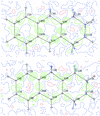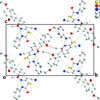issue contents
June 2021 issue

Cover illustration: Not all space-group symmetries are common, indeed some are exceedingly uncommon. 3,6-Dihydroxypicolinic acid, C6H5NO4, forms crystals with an unusual space group of type Abm2. In the structure, layers of hydrogen-bonded molecules extend parallel to the ac plane. It also exhibits whole-molecule disorder and minor twinning by inversion. See: Berman & Parkin [Acta Cryst. (2021). E77, 623–628].
research communications
Download citation


Download citation


The crystal structure of magnesium zinc divanadate can be described by an alternate stacking of V2O7 layers and (Mg/Zn) atom layers. Each V2O7 layer consists of a V2O7 dimer and a V4O14 tetramer.
CCDC reference: 2080585
Download citation


Download citation


The structure of KHBEt3 is polymeric, involving chains linked by K—H—K motifs via the hydridic hydrogen.
CCDC reference: 2081809
Download citation


Download citation


The conformation of the title compound is partially determined by a strong, intramolecular O—H⋯O hydrogen bond. In the crystal, C—H⋯O hydrogen bonds link the molecules, forming chains along the a-axis direction, which are linked into strongly corrugated sheets parallel to the ac plane by C—H⋯O hydrogen bonds and C—H⋯π(ring) interactions. The sheets are associated through additional C—H⋯π(ring) interactions.
CCDC reference: 2082055
Download citation


Download citation


In the crystal, O—H⋯N and N—H⋯O hydrogen bonds link pairs of molecules via two methanol molecules. These molecules are connected to each other by C—H⋯N hydrogen bonds and form columns along the a-axis direction.
CCDC reference: 2081515
Download citation


Download citation


The title compound, which crystallizes in the monoclinic C2/c space group with one half-molecule in the asymmetric unit, was synthesized by Suzuki–Miyaura cross-coupling reaction of 9-bromoanthracen-2-ylium with pyridin-4-ylboronic acid.
CCDC reference: 2072800
Download citation


Download citation


Crystal structure of potassium hydrogen bis((E)-2-{4-[3-(thiophen-3-yl)acryloyl]phenoxy}acetate)
The title compound, C30H23KO8S2, contains one molecule of (E)-2-{4-[3-(thiophen-3-yl)acryloyl]phenoxy}acetic acid and one molecule of its potassium salt in the asymmetric unit. The distorted KO6 octahedra share edges, resulting in chains running in the [010] direction.
CCDC reference: 2082049
Download citation


Download citation


The N-substituents lie on opposite sides of the pyrazole ring. Intermolecular hydrogen bonds from the amino group to an S=O group and to the oxo substituent lead to a layer structure.
CCDC reference: 2082046
Download citation


Download citation


N-H, N-phenyl and N-benzyl-2-(4-hexyloxyphenyl)benzimidazoles were prepared and studied by 1H NMR and single-crystal X-ray analysis. The unsubstituted benzimidazole forms intermolecular N—H⋯N bonds while in the crystal structures of the other two compounds, the molecules are assembled only through π–π and C—H⋯π interactions.
Download citation


Download citation


A two-step synthesis of 3,6-dihydroxypicolinic acid, its crystal structure and that of a labile intermediate, are described.
Download citation


Download citation


N—H⋯Cl hydrogen bonds link two dihydroquinazolinium cations and a tetrachlorido zincate dianion into discrete aggregates. Neighbouring (C12H15N2)2[ZnCl4] units interact via non-classical C—H⋯π hydrogen bonds and π–π stacking.
CCDC reference: 2082994
Download citation


Download citation


The structure of Ba5(IO6)2 has been redetermined at two different temperatures, namely 298 and 80 K, with a high crystalline single-crystal. In comparison with previous determinations based on powder diffraction patterns, the present redetermination results are of greatly improved precision of the structural parameters. The ambiguity of the space-group assignment was eliminated with three-dimensional patterns from a single-crystal sample.
Download citation


Download citation


The title molecule adopts an angular conformation. In the crystal, N—H⋯O and N—H⋯N hydrogen bonds together with C—H⋯π(ring) interactions form chains extending along the a-axis direction. Additional N—H⋯O hydrogen bonds link the chains into layers parallel to (100).
CCDC reference: 2083102
Download citation


Download citation


The dihydroquinoxaline moiety, with the exception of the N atom, is essentially planar with the attached phenyl ring inclined to it by 11.64 (6)° and the inner part of the methylpropanoate group nearly perpendicular to it. In the crystal, inversion dimers formed by C—H⋯O hydrogen bonds are connected into oblique stacks by π-stacking and C—H⋯π(ring) interactions.
CCDC reference: 2062956
Download citation


Download citation


The crystal structure of μ-methylene-bis[(dibromo)(diethyl ether-κO)aluminium(III)] has established that the Al—CH2—Al angle, 118.4 (2)°, is the smallest observed for structure where this moiety is not part of a ring.
CCDC reference: 2084539
Download citation


Download citation


The photoreactive behaviour of the title compound, C20H23NO2, was investigated. Solid-state photoreaction did not occur in the solid-state but it occurred in acetonitrile solution.
CCDC reference: 2085220
Download citation


Download citation


The title compound, C22H18N2O2, is a Schiff base that exists in the phenol–imine tautomeric form and adopts an E configuration. The molecular structure is stabilized by an O—H⋯N hydrogen bond, forming an S(6) ring motif.
CCDC reference: 2085577
Download citation


Download citation


The title molecule adopts a conformation with the two phenyl substituents disposed on opposite sides of the mean plane of the isoquinoline unit. In the crystal, corrugated layers of molecules are formed by N—H⋯O, C—H⋯N and C—H⋯S hydrogen bonds together with C—H⋯π(ring) interactions. These layers are connected by C—H⋯O contacts.
CCDC reference: 2085564
Download citation


Download citation


The structure of the title ocyacopper cluster contains two C16H18Cu4F18O4 units linked through a center of inversion by weak Cu—O bonds.
CCDC reference: 2085512
Download citation


Download citation


The molecular structure of the newly synthesized dye (E)-1-[2-(5-chloro-2-hydroxyphenyl)hydrazinylidene]naphthalen-2(1H)-one was determined by X-ray diffraction at 173 K. The asymmetric unit of the title contains two crystallographically independent molecules, which adopt an s-trans conformation.
CCDC reference: 2085853
Download citation


Download citation


In the title complex, [Cu(C22H44N4)(H2O)2][Cu(C22H44N4)]Br4·2H2O, each of the two complex cations lies about an inversion center. The two macrocyclic rings adopt the most stable trans-III configuration. In the crystal, O—H⋯Br, N—H⋯Br, N—H⋯O and C—H⋯O hydrogen bonds connect the complex cations, bromide anions, semi-coordinating H2O ligands and water solvent molecules, forming a one-dimensional network extending parallel [100].
CCDC reference: 2086077


 journal menu
journal menu






































